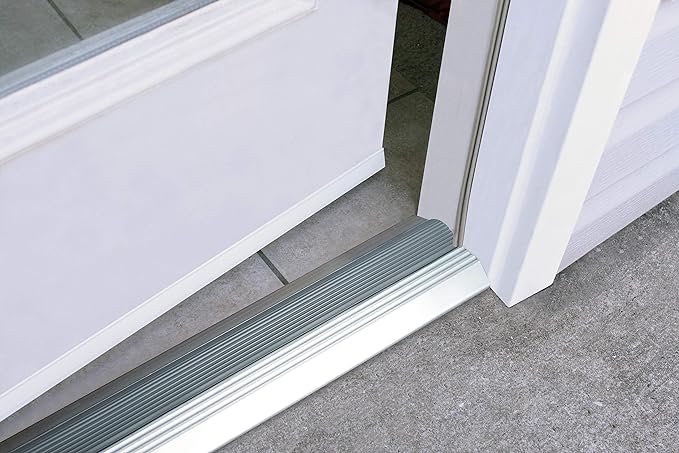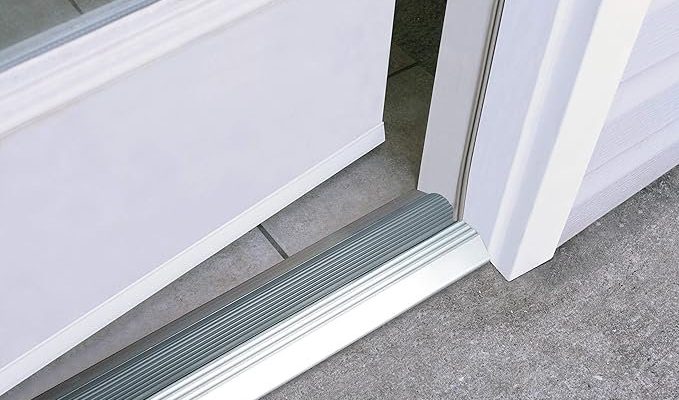
Here’s the thing: doors and thresholds work together like dance partners, not just in style but in how they handle movement, pressure, and sound. If one partner (the door) comes in too strong or isn’t lined up just right, the other (the threshold) can’t help but react. Different brands and styles—whether you’ve got a smooth, rubber-sealed threshold from Schlage, a classic wooden step from Home Depot, or even a high-tech weatherproof model—can all run into this issue.
No matter what brand you’ve installed or what type of entryway you’ve got, the basics are the same. Let me explain exactly *why* your threshold vibrates when the door closes, the science behind it, and what you can do about it.
What Causes a Threshold to Vibrate?
At its core, the threshold is the strip of material—often wood, metal, or composite—that sits underneath your exterior door where it meets the floor. When you close your door a little too firmly, a surprising amount of energy transfers into that threshold. Doors are heavier than most folks realize, and the force you use to shut them doesn’t just disappear. Instead, it travels through hinges, into the frame, and finally, down to the threshold.
The threshold acts like a bridge. Instead of flexing under pressure, it can send vibrations through the floor or subfloor. If the fit isn’t perfect, or if your door is out of alignment, the impact is even stronger. Some brands, especially those with hollow-core doors or lightweight frames, are more likely to transmit vibrations than solid, well-fitted ones.
You might notice the vibration more when:
- The door is slammed shut rather than gently closed.
- The weatherstrip or seal isn’t absorbing shock.
- Your floor or subfloor is less stable—think older homes or second-story entries.
Sometimes it’s one clear cause; other times, it’s a mix of small issues adding up. Either way, understanding the path of energy helps you zero in on the real culprit.
How Door Construction and Weight Play a Role
Let’s talk about how your door itself factors in. The weight, material, and even the way your door is hung can all change how much your threshold vibrates. For example, a solid oak front door is going to transfer a lot more force than a lightweight, hollow-core interior door. The reason? Mass and momentum.
Here’s a quick mental image: Imagine tossing a pillow onto your floor versus throwing a bowling ball. The pillow barely makes a dent, but the bowling ball? That’s a whole different story. In the same way, heavier, denser doors don’t just close—they hit with a punch, sending that energy into whatever they touch next.
The *way* your door closes matters, too. Some entry doors are spring-loaded for tight security, or have strong hinges that pull the door inward with a snap. If the door isn’t properly “soft-closed” with a weatherstrip, it’s like dropping a hammer onto the threshold. All that momentum has to go somewhere, and your threshold becomes the release valve.
Brands like Schlage or Kwikset often use thicker, heavier doors for better insulation and security. While this is great for protecting your home, it can mean bigger vibrations unless everything’s perfectly aligned and cushioned.
The Role of Seals, Weatherstripping, and Gaskets
Now, let’s get into the stuff you don’t always see: the seals, weatherstripping, and rubber gaskets. These little strips are your threshold’s best friends. They act as shock absorbers and insulators, stopping both drafts and excess movement. When your door closes against a nice, springy seal, that impact gets softened—kind of like a car tire hitting a speed bump instead of a curb.
If the seal is old, cracked, or missing altogether, every forceful close sends shock waves right through the threshold. Over time, even the toughest threshold can start to rattle and vibrate. Here’s what to watch for:
- Weatherstripping that’s flat, brittle, or falling off
- Missing or worn door-bottom gaskets
- Loose or badly-fitted seals (sometimes you can actually see daylight under your door)
Honestly, the difference between a brand-new, cushioned seal and a worn-out one is night and day. If you’ve ever replaced your own and suddenly noticed your door closing with a gentle “thud” instead of a “clang,” you know exactly what I mean.
Loose Fasteners, Subfloor Issues, and Installation Mistakes
Sometimes, the threshold itself isn’t the problem—it’s how it’s attached or what’s underneath it. Thresholds are usually anchored with screws or nails straight into the subfloor, but if those fasteners work loose? Cue the rattle and the shake.
Subflooring plays a big role, too. In newer homes, subfloors are often rigid plywood or composite panels, but older homes might have gaps, squeaky boards, or even rot. If the base isn’t firm, any impact from the door will turn the threshold into a little drum.
Installation matters more than you’d think. If the threshold wasn’t measured to fit tightly, or if it’s sitting on uneven ground, any downward force from the door can cause flexing. You might even hear *vibrations* in the floor nearby, not just right at the threshold.
Let me sum up: If your threshold is wobbly, the screws are loose, or the floor beneath it isn’t solid, you’re going to feel every door close like a mini earthquake. Fixing these basics is often the fastest way to calm things down.
Why Door Alignment and Strike Plate Placement Matter
Door alignment sounds a bit technical, but it really just means: does the door fit perfectly in its frame? If it’s even a little off—too high, too low, leaning to one side—every time you close it, you’re putting uneven pressure on everything it touches. This is especially true for the threshold, which gets the brunt of the impact if the spacing is wrong.
The strike plate, that little metal piece on your door jamb, guides the latch into place. If it’s out of position, you might have to slam the door harder to get it to latch, and that means more shock for the threshold. Even doors that “almost” fit can cause repeatable vibrations you’ll notice every single time.
Real-life story: A friend of mine moved into a house with a slightly crooked door. They just thought it was “quirky” until every entry felt like a mini drumroll underfoot, especially on windy days. Once they rehung the door and adjusted the strike plate, the threshold stopped vibrating completely.
So, if you’ve tried everything else, double-check your door’s alignment. Sometimes, all it takes is a few turns with a screwdriver and a new strike plate to solve the problem.
Weather and Humidity: Seasonal Effects on Your Threshold
Believe it or not, the *weather* can change how much your threshold vibrates. Wood and even some composites expand and contract with humidity and temperature swings. During wet spells, doors might swell and stick, hitting the threshold harder when you close them. In dry weather, gaps can form, making the door looser and more likely to rattle.
Metal thresholds might seem immune, but they actually expand and contract with temperature, too. This can open up tiny gaps that weren’t there a month ago, letting the door hit harder or even unevenly.
Weatherstripping can become stiff in cold weather and lose its springiness, meaning it won’t absorb shock as well. If your home experiences big seasonal changes, don’t be surprised if your threshold vibrates more at certain times of the year.
Keeping an eye on these seasonal patterns can help you know when to check the seals, adjust the door, or refasten loose screws. Sometimes, it’s as simple as adding, removing, or tweaking weatherstrips as the months change.
How to Troubleshoot a Vibrating Threshold
Alright, let’s get hands-on. If your threshold vibrates when the door closes, here’s a step-by-step way to hunt down the cause and fix it:
- Check the seal: Inspect weatherstripping and gaskets for wear or gaps. Replace anything brittle, cracked, or missing.
- Test the screws: Try wiggling the threshold. If it moves, tighten all the fasteners down to the subfloor. Replace any stripped screws with longer or thicker ones for a tighter hold.
- Look at the door alignment: Does the door fit snugly in the frame, or is it dragging or leaving a visible gap? Adjust hinges or strike plates as needed.
- Soften the landing: Add or replace a soft weatherstrip or rubber gasket where the door meets the threshold. This helps cushion the impact.
- Inspect the subfloor (if possible): For chronic, severe vibrations, check what’s under the threshold. Reinforce or replace any soft, squeaky, or rotted areas.
If you’re dealing with a branded, high-end threshold—like a smart weather-sealed model from Schlage—you might have extra adjustment options or even built-in shock absorbers. These can make fixing vibrations a little easier, but the basics above still apply.
Pro tip: Sometimes, a universal door sweep or aftermarket weatherstrip can make a world of difference. No need for fancy tools—just measure carefully, cut to size, and stick or screw it in place.
If you’re still stuck, it could be worth calling in a pro. Persistent, whole-house vibrations might point to bigger issues with framing or flooring.
When to Worry: Signs of Bigger Problems
Most of the time, a vibrating threshold is more of an annoyance than a major problem. But there are situations when you really should pay closer attention. If the vibrations are getting worse over time, or you’re starting to notice cracks, popping sounds, or visible movement in the floor or walls, it might be more than just a loose seal.
Here’s what can signal bigger issues:
- Repeated loose screws: If you keep tightening them and they keep working loose, the underlying wood or subfloor might be crumbling or rotten.
- Visible gaps: Large spaces between the threshold and the floor, or between the door and the frame, can mean settling or shifting in your home’s foundation.
- Strange noises: Creaking, popping, or grinding sounds when you close the door can point to problems with the framing, not just the threshold.
In these cases, don’t just address the threshold—get a pro to check the structure. Early fixing can save you a lot more trouble and money down the line.
How Different Threshold Types and Brands Compare
Not all thresholds are created equal. The material, shape, and even the brand can change how likely they are to vibrate. Let’s lay it out:
- Wooden thresholds: Traditional, but can become loose or warped over time. They’re easy to refinish but can transmit more vibration if the seal is worn out.
- Metal thresholds: Durable and long-lasting—great for weather-resistance but can be noisy if not installed snugly. Some have built-in rubber gaskets that help reduce vibration.
- Composite thresholds: Often used in newer homes; these mix wood and plastic for stability and good shock absorption.
- Brand-specific upgrades: Models from brands like Schlage sometimes offer extra features like built-in seals or adjustable heights. These can help solve vibration issues if installed correctly.
If you’re planning a replacement, it’s worth checking out what extra options are available for your door’s brand and type. Some universal replacement thresholds fit almost any door—but always measure and double-check compatibility before you buy.
Final Thoughts: Keeping Your Threshold Silent and Steady
At the end of the day, a vibrating threshold might seem like a small thing, but it’s usually your home’s way of telling you something needs attention—whether it’s a loose screw, a missing seal, or just a door that’s a tad too heavy for its frame. By understanding how energy moves from door to floor, you’ll not only quiet those rattles but also help protect your home from drafts, pests, and even water leaks down the road.
If you take a careful look—checking seals, tightening fasteners, and making sure everything lines up—the fix is often simple and satisfying. And hey, next time your threshold stays silent when the door closes, you’ll know exactly why.
